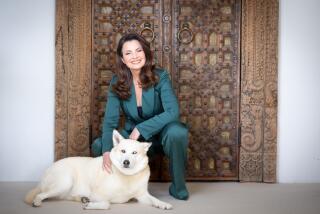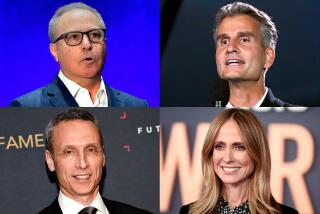Opposite Ends of the Ice : Goodenow Will Wage Fight Against a Cap
- Share via
What you need to know about the dark ages of NHL labor negotiations can be summed up by the nicknames of the two principals who once were the most powerful men in hockey.
Ziggy and Iggy.
Former NHL President John Ziegler and R. Alan Eagleson, executive director of the NHL Players Assn., were not exactly adversarial, setting a most disturbing trend in labor relations. They were running mates--attending Wayne Gretzky’s wedding and traveling to the Soviet Union together.
When Gretzky was traded from the Edmonton Oilers to the Kings in August of 1988, Ziegler was tracked down for a comment. He was found on the golf course, sharing a cart with Eagleson. Thus, there was little surprise that Eagleson’s charges--the players--were docile.
What you need to know now is that NHL Commissioner Gary Bettman and the current executive director of the NHLPA, Bob Goodenow, won’t be tending the flag for each other. Or sampling strawberries and cream together courtside at Wimbledon.
While it might be easiest to define Goodenow by what he is not--namely, Eagleson--that is the incomplete way. Eagleson, after all, is under federal indictment for racketeering. Government authorities are trying to extradite him from Canada.
In about a two-year span, Goodenow, 41, has helped change the adjective describing the union’s image from supplicant to militant . In 1992, he led the players in a 10-day strike, the first such stoppage in league history. Now, faced with a Friday deadline for a season-opening lockout from Bettman, Goodenow is not flinching, saying that the latest proposal from the owners is unacceptable and that it still essentially caps salaries.
“I don’t think they look at Mr. Goodenow as being the same as Mr. Eagleson,” said King defenseman Marty McSorley, a member of the NHLPA’s negotiating committee.
McSorley paused and started to smile, saying: “They see Mr. Goodenow sitting on our side of the table this time.”
Goodenow’s background is especially intriguing considering that he comes to the table having been on both sides of a labor dispute. Before becoming a player agent in 1984, Goodenow stared down the Teamsters in a 1983 dispute between the union and a fire-fighting equipment manufacturer. Representing management, Goodenow kept the union out for 11 months before the Teamsters gave in.
“It makes me sick to my stomach he’s head of a union,” retired Teamsters official Frank Caputo of Pittsburgh told a reporter in 1992. “There’s no doubt he’s a union buster. He’s the most difficult man I’ve ever dealt with.”
Moving to the union’s side didn’t bring praise from management, either, in the aftermath of the players’ strike in 1992. Chicago owner Bill Wirtz called him unprofessional and said he didn’t know which way “this rabbit” is going to jump.
Such rhetoric--past, present and future--glances off the feisty redhead like a weak slap shot. Goodenow relished verbal battles as a law student at the University of Detroit and physical ones when he was a hard-hitting forward with a booming slap shot for the U.S. national junior team and as co-captain at Harvard.
“It happens any time you get into labor issues,” Goodenow said. “A lot of people don’t like labor or a differing uncompromising situation. The level of conflict can get quite high. It’s not like going before a judge and having the issue decided.
“It’s the nature of the business that brings out that level of emotion. Some people don’t like it. I find labor situations fascinating, issues how it relates to a sport.”
Labor relations can get to the point where emotion turns deadly. In Pittsburgh, Goodenow once had to secure a license to carry a handgun when he was involved in a tense negotiation. Years later, he downplayed the situation.
“It was a dispute that got heated,” he said. “It was over 10 years ago.”
Does he still have that license?
“Oh, no,” he said.
That may have been his most dangerous moment as a labor lawyer. This current standoff with the NHL, of course, is his most public.
“At any point in time, you think something is important,” Goodenow said. “But I haven’t slotted it in my mind. At the moment, it’s this.”
With this dispute, not only does Goodenow have a responsibility to his far-flung membership of about 600 players, but hockey’s players union is being closely watched by other sports, especially baseball.
After all, no union leader wants to be known as the next Gene Upshaw, who has been widely criticized for football’s salary cap.
Reputations are made and broken in labor negotiations. If Bettman is perceived to have lost, no one will remember all of his positive accomplishments. Likewise with Goodenow, who has been lauded for creating a stronger, more informed union.
He has repaired years of inequity, turning union business into a give-and-take operation, rather than one shrouded in secrecy. Players needing a quick answer can count on getting one by the end of the day from Goodenow himself.
“I think it has changed, everybody realizes that now,” King defenseman Charlie Huddy said. “Before the strike (in 1992), everybody used to think the players union was just a way to get benefits, not much more. Now we’ve learned we have to stick together, especially when things happen like cutting one man of the roster. Because that one person could easily be you.”
Said Goodenow: “The players are continually increasing their level of knowledge. And that’s helpful. Players have to live their life and make decisions. The key is to make sure the players are informed.”
Equally important, Goodenow has the strong support of key player agents, such as Winnipeg-based Don Baizley, who represents Teemu Selanne, Jari Kurri and Paul Kariya, among others, and Los Angeles-based Mike Barnett, who has Gretzky, Brett Hull, Alexander Mogilny, Jaromir Jagr and Sergei Fedorov among his clients. Clearly, the rank and file players are important, but it means little without the backing of hockey’s stars.
“He’s very thorough and conscientious and can come across as very guarded,” Barnett said. “But those who know him well know that the guard that appears to be up there is a person who is interested in being a listener instead of a talker.
“There’s an old adage of what isn’t said in a negotiation versus what is said is often the most important thing. That adage is Bob Goodenow personified.
“But out of the business suit and in jeans going to the hockey rink with his own young son, he is just another parent who is very supportive.”
Baizley believes Goodenow’s experience as a player has served him well in his term as executive director.
“Bob moves amongst his constituency easily, he’s comfortable in a locker room,” Baizley said. “Apart from the economic aspects, he has an attachment to the soul of the game. I think it’s an advantage.”
McSorley, who has spent a great deal of time with Goodenow in recent weeks, is comfortable about the union’s leadership and solidarity.
“I hope the unity isn’t underestimated,” McSorley said. “If we’re put to the wall, you always know that the tiger is most dangerous when it is cornered.”
More to Read
Go beyond the scoreboard
Get the latest on L.A.'s teams in the daily Sports Report newsletter.
You may occasionally receive promotional content from the Los Angeles Times.







